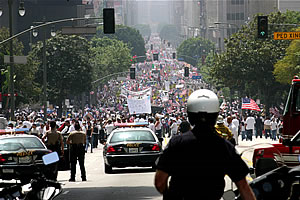Student Action: Make Your Voice Heard

(Shutterstock.com)
Options for Affecting Public Policy
People in the United States have many options for making their opinions heard on issues facing the country and their communities. The First Amendment of the U.S. Constitution guarantees the rights of free speech, free press, petition, and assembly. These rights assure that political parties, interest groups, and individuals can influence the making of laws and governmental policies. The First Amendment allows peaceful methods for influencing elected representatives.
Choosing the best way to influence the political process can be a challenge. Questions arise about what method would be the most effective. What benefits does a particular approach offer? What are its potential costs? Political experts and everyday people often debate these questions. Not everybody agrees.
One approach to affecting public policy and opinion is by demonstrating. A demonstration can include marching, picketing, and walkouts by large numbers of people. Demonstrations have certain benefits. They can capture the attention of the news media and draw attention to the issue or cause. If large numbers of people are involved, demonstrations can show that many people have strong feelings about the issue. If demonstrations disrupt normal business, they can put pressure on officials.
Demonstrations can also have a downside. If they disrupt peoples' lives, they can cause resentment and alienate those who might be supportive. If they become violent, they can sway public opinion against the marchers. Because demonstrations can get so much media attention, they can solidify opposition.
The 2006 nationwide student school walkouts protesting proposed changes to federal immigration law serve as an example. Supporters argued that that the demonstrations drew media coverage and focused greater public attention to the issues involved and showed that many students were strongly opposed to more restrictive immigration laws. They argued that the demonstrations showed that the young people involved were committed to their cause and exercising the rights of free expression and assembly non-violently.
Critics of the demonstrations argued that the walkouts were illegal and disrupted schools and the education of the youths involved. They also pointed out that some of the schools affected could lose funding because students were not in school and those students could face discipline for walking out. Others also criticized some demonstrators, claiming that unruly behavior and waving Mexican national flags could actually hurt the cause supported by the students.
In addition to demonstrations, there are many other methods for affecting policy.
As you review each of the following approaches consider its benefits and costs. For each, discuss the following questions.
- What is the purpose of this approach?
- What are some of its potential benefits?
- What are some of its potential costs?
- Under what circumstances, would this approach be appropriate and get the best results?
![]()
Click on any of the suggested actions below to get started making your voice heard!
- Letters to the Editor
- Letters to Officials
- Letter-Writing Campaigns
- Petitioning
- E-Mail and Telephone Campaigns
- Lobbying
- Meeting with a Lawmaker
- Testifying


